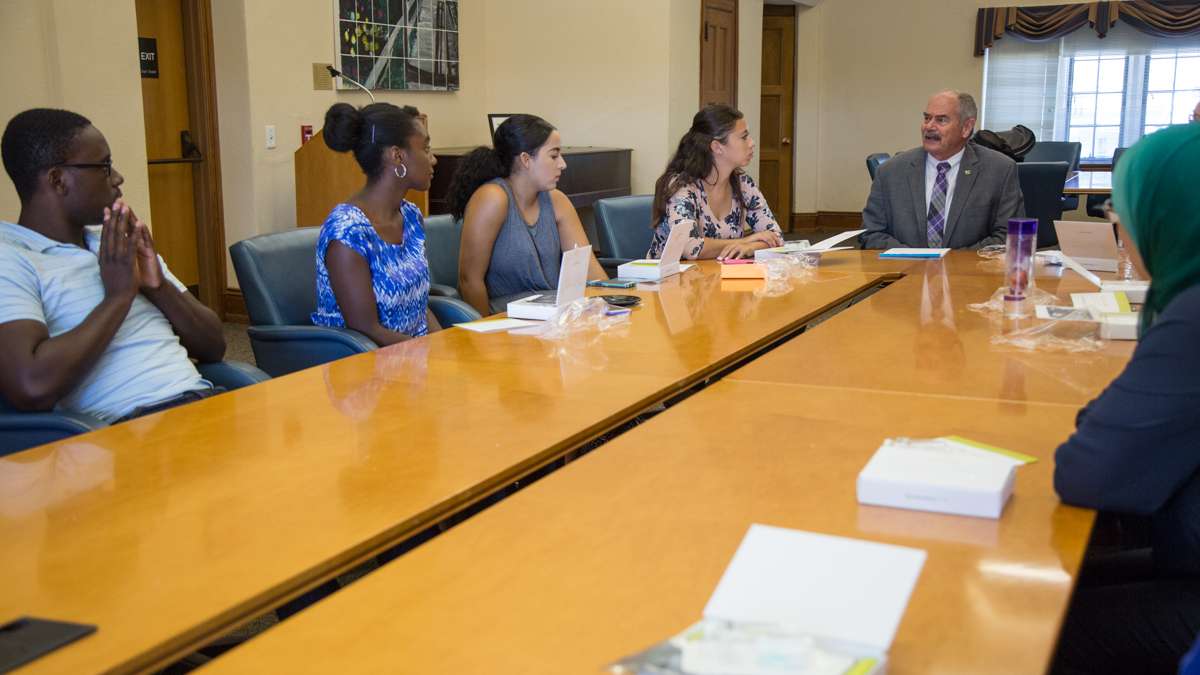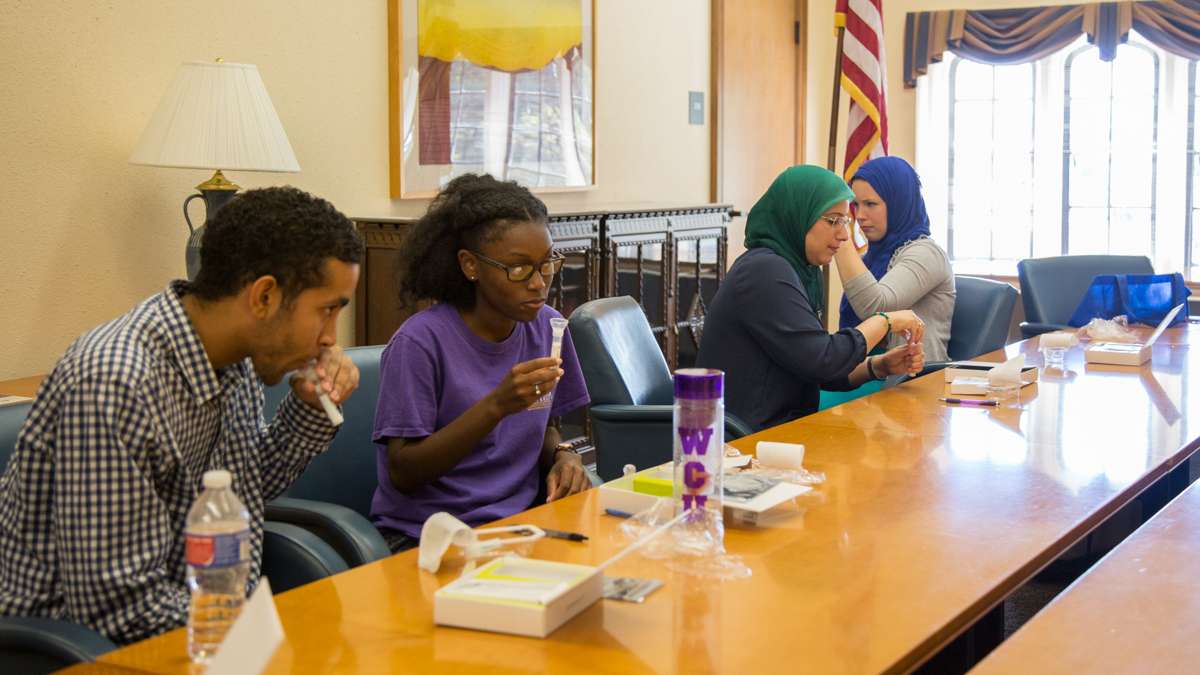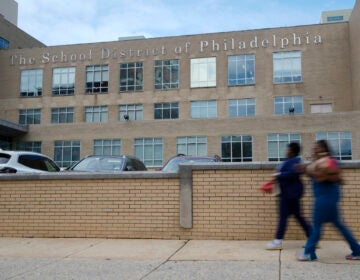Exploring genetic roots to help students understand race, themselves
ListenWhat if you found out you weren’t really who you thought you were?
A West Chester University project is using DNA to unearth surprises and start conversations about identity and race.
Before students at West Chester could trace their roots, they had to learn how to use their DNA-testing kits. They’re part of the project “One University, One Ancestry,” which looks at the DNA of students, faculty and alumni. Communication studies professor Anita Foeman founded it.
“I thought, now, wouldn’t it be interesting to test somebody and see if their ancestry DNA said the same thing that they did in their narrative about their racial background,” she said.
The project kicked off this summer, but is part of a larger DNA project Foeman started 10 years ago, the DNA Discussion Project.
She will have tested more than 1,000 people by the end of the fall semester.
It’s complicated
“I found in particular that the narratives of somebody’s racial background tended to be very simple. But their actual ancestry was quite complicated,” she said.
Communication studies associate professor Bessie Lawton is working with Foeman on the project.
People tend to think of themselves as only one race, she said, but test results are more complicated.
“Everybody in their DNA profile has more than one race or ethnicity,” said Lawton.
That’s partly because people either overestimate or underestimate race in their background, she said.
“People who think they are white overestimate that they are white. And there’s a lot of underestimation, especially for categories such as Asian and Latino,” she said.
People also tend to overestimate Native American roots and underestimate African ancestry.
The disparity is also because family histories are usually only a few hundred years while genetic information can span thousands of years.
Before testing, participants fill out a survey of how they identify. And then they complete a second survey after they have their results.
Unearthing surprises
University president Greg Weisenstein welcomed the students as they completed their tests.
“I think what makes this so exciting is that it reveals a lot of things about us,” he told them. “And probably a whole lot about who we thought we were, which may not be correct. I know in my case, there were some surprises in my DNA test.”
Weisenstein knew of his German and Austrian background, but his test results also showed European, African, Asian and Middle Eastern ancestry.
“That’s the neat part of this project,” he said. “It reveals the fact that we all have very common backgrounds, and that we all are of a single family, if you will. And it has some real implications in terms of how we should be thinking about each other and treating each other.”
Senior Daniel Schwartzman was confident he’s 100 percent Haitian.
“If it turns out I’m not Haitian, if it turns out that I’m from Sweden, then I don’t know. I may need to take some time to re-evaluate my life,” he said, laughing, last summer when he was awaiting his test results.
As it turns out, Schwartzman’s DNA says he’s 92 percent African and 8 percent European.
“It’s crazy to be 8 percent,” he said. “I mean that doesn’t sound like a lot, but when you don’t think you’re any percent, I probably assume I’m 100 percent African, so it’s crazy,” said the 22-year-old. “But it does make sense.”
Broader conversations
The project is an attempt to create more positive discussions about race. Social studies teacher Michael Santangelo hopes to do that too. He teaches an American government class to seniors at Norristown Area High School.
The school is 46 percent black, 30 percent white and 23 percent Latino.
“If I could show them that I had diversity, and they didn’t see me as just the white-guy teacher, I thought that would be a good way to kind of open the door to the discussion on race,” he said.
Since he’s Italian, he thought he might have African ancestry.
“But what came back was close to 10 percent Middle Eastern,” he said.
In a class discussion about what the characteristics of a country are, including population, he asked students to define “race.” They gave answers including ethnicity, skin color and where your ancestors are from.
“But even when I had them define race, they looked very reluctant to want to define it, because I think it has been sort of a taboo subject,” he said.
He hopes the DNA Discussion Project will change that.
“It’s fun, and I think I saw that in the students’ eyes who want to participate. And I would say almost 80 percent of every class looked like they were interested in doing it.”
Santangelo is trying to secure grant funding for the students to be tested. Each kit costs $120, and testing is done by Ancestry.com.
“It’s not something you could test on some sort of state test, but I think it’s more important for us to realize as we’re preparing citizens to go out into the world,” he said. “And if we can have them open up and have some very good discussions about race, nationality, ethnicity, I think that would be a good thing.”
Difference within
Project co-director Lawton said one way to promote diversity and reduce prejudice is by talking to those who are different. But this project reveals the difference might not be from the outside.
“If you add the story of genotypes, and you find out that that difference is within yourself,” she said. “It makes you start to think about, ‘Well, maybe I am not that different from other people.'”
Dayonna Park, graduate assistant for the project, grew up in a predominantly white neighborhood in Philadelphia, where she felt she stood out and didn’t belong.
Park, who is Korean and black, transcribes the project interviews, including ones of biracial participants.
“Hearing those interviews almost brought tears to my eyes,” she said. “Because they’re here at a place that I almost thought was very homogeneous, you know. And yet here they are, doing these interviews, sharing my same perspective. It was just so eye-opening.”
The graduate student in psychology was DNA tested, but hasn’t gotten her results yet.
Even without the results, the project is already having an impact. Park grew up straightening her hair, but has now embraced her natural curls.
“That’s how much this project has really kind of gotten to me. Because that was an immediate change I made without even thinking about it,” she said.
Researchers at West Chester hope to expand the project to locations including Delaware County Community College.
They will share their project findings and host community discussions in the spring.
WHYY is your source for fact-based, in-depth journalism and information. As a nonprofit organization, we rely on financial support from readers like you. Please give today.











